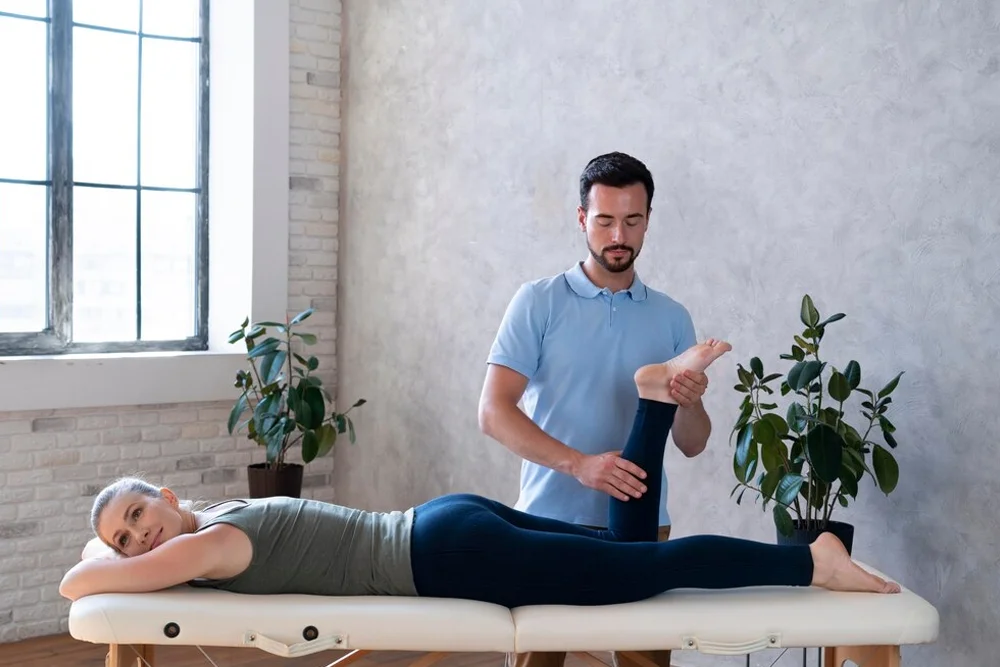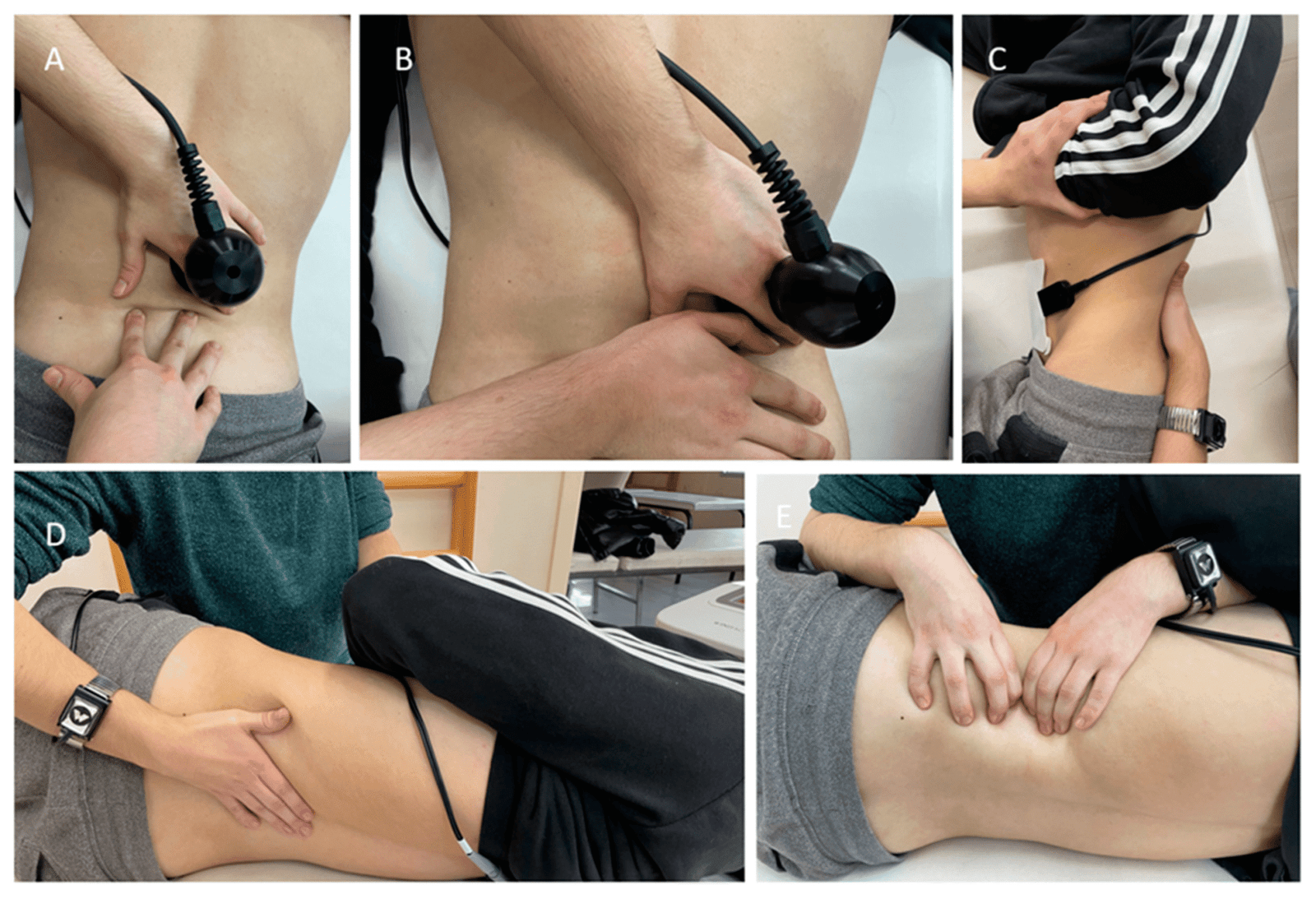Imagine doing everyday tasks — walking, sneezing, laughing — without worrying whether you’ll leak urine, feel sharp pain, or avoid intimacy out of fear. Or being free from the constant low-grade ache in your pelvis that just never seems to go away.
Pelvic Floor Therapy
Imagine doing everyday tasks — walking, sneezing, laughing — without worrying whether you'll leak urine, feel sharp pain,
On this page
- What is the Pelvic Floor — and Why Care?
- What is Pelvic Floor Therapy?
- What Does the Evidence Say?
- Healing Pain, Regaining Control: What the Journey Looks Like
- Practical Tips: What You Can Do Now
- When Therapy Alone Isn’t Enough — What Else Helps
- Myths & Misconceptions
- Regaining Confidence: It’s About More Than Physical Healing
- When to Seek Help
- Your Roadmap to Heal, Regain, and Live Confidently


Imagine doing everyday tasks — walking, sneezing, laughing — without worrying whether you’ll leak urine, feel sharp pain, or avoid intimacy out of fear. Or being free from the constant low-grade ache in your pelvis that just never seems to go away. For many people, these are daily realities due to pelvic floor dysfunction. Fortunately, pelvic floor therapy offers a path to healing. This blog explains what pelvic floor therapy is, why it works, how it’s done in practice, and what you can do to regain control and confidence.
What is the Pelvic Floor — and Why Care?
The pelvic floor is a group of muscles, ligaments, and connective tissues that span the base of the pelvis. They support pelvic organs (bladder, uterus in people who have one, prostate in men, bowel), help with bladder and bowel control, stabilize the pelvis and spine, contribute to sexual function, and are involved in childbirth. Problems in this system can manifest as weakness (leading to leaking), or excessive tightness (leading to pain), or coordination issues (difficulty relaxing or contracting at the right time).
Pelvic floor dysfunctions are common: after childbirth, aging, surgery, chronic illness, obesity, or following injury. They may involve:
- Urinary or fecal incontinence
- Pelvic organ prolapse
- Pain during intercourse (dyspareunia), vaginismus
- Chronic pelvic pain syndromes
- Overactive bladder
- Constipation or difficulty evacuating
When these symptoms are present, they can affect quality of life: physical, emotional, social.
What is Pelvic Floor Therapy?
Pelvic floor therapy (sometimes called pelvic floor physical therapy, PFPT) is a specialized form of treatment that targets these muscles, connective tissues, nerves, and behaviors that contribute to dysfunction. The goal is to restore their proper strength, control, flexibility, coordination, and resting tone — whether they are weak, too tight, or “stuck.”
Components of pelvic floor therapy may include:
- Assessment: Taking history, examining posture, movement patterns, muscle strength, resting tone (i.e. is the muscle too tight?), flexibility, and coordination.
- Manual therapy / myofascial release: Hands-on work to release tight muscles, scar tissue, connective tissue restrictions.
- Biofeedback: Using sensors to help you learn how to contract or relax pelvic floor muscles accurately.
- Electrical stimulation: Gentle stimulation to assist weak muscles or to help relax overactive ones.
- Relaxation techniques: Breathing work, pelvic “down-training” exercises (learning to let go).
- Strengthening exercises: Often “Kegel”-type, but more than simple squeezes. Working on endurance, speed, coordination.
- Behavioral education & lifestyle changes: Toileting habits; posture; lifting mechanics; diet (e.g. to avoid constipation); modifying activities that worsen symptoms.
- Home program: Exercises, awareness, self-care between therapy sessions.
What Does the Evidence Say?
Below are some of the key findings from recent research, to show what pelvic floor therapy can do and where its limits are.
- Urinary Incontinence and Prolapse in Women
Pelvic floor muscle training (PFMT) is considered a first-line, conservative treatment for urinary incontinence, pelvic organ prolapse (POP), and postpartum pelvic floor issues. It has “robust evidence-based support” for improving or curing symptoms of urinary incontinence, fecal incontinence, peripartum/postpartum dysfunction, hypertonic disorders (where muscles are too tight), dyspareunia, vulvodynia, and more. - Chronic Pelvic Pain
Chronic pelvic pain (CPP) is notoriously complex because causes may include endometriosis, interstitial cystitis, nerve irritation, myofascial pain, and more. PFPT or multimodal physical therapy (which includes PFPT) is increasingly shown to reduce pain and improve quality of life in people with CPP. A recent systematic review found that multimodal physical therapy is effective in women with chronic pelvic pain with high certainty of evidence.
For example, one study (Pelvic pain rehabilitation, 2018) showed that compared to control groups, subjects receiving pelvic floor rehabilitation had statistically significant improvement in pain and quality of life by 12 weeks. - Low Back Pain
There’s growing evidence that pelvic floor muscle training in addition to standard physical therapy helps people with low back pain, especially in pregnancy. One recent meta-analysis (Lim et al., 2024) found that PFMT gave a clinically meaningful reduction in pain in low back pain patients, with some improvement in disability. - Effect Size, Certainty, and Limitations
- Much of the evidence is good, but in many cases evidence certainty is low: study sizes are small; methods differ; long-term follow-up is often lacking.
- PFPT works best when tailored to the individual — strengths, weaknesses, hypertonicity vs hypotonicity, pain trigger factors. One-size-fits-all is less likely to succeed.
- Active engagement is key — doing home exercises, learning to self-monitor, modifying behavior. Therapy sessions alone are often not enough.
- Guidelines and Consensus
- Many clinical guidelines (e.g., European Association of Urology, American urogynecology) recommend PFPT as first-line, non-surgical treatment for many pelvic floor disorders.
- For chronic pelvic pain, major guidelines emphasize a biopsychosocial, multidisciplinary approach: physical therapy + psychological support + behavioral therapies rather than medication or surgery alone.
Healing Pain, Regaining Control: What the Journey Looks Like
Here’s a roadmap to what a “real-life” pelvic floor therapy journey might be like. Everyone’s path is different, but these steps capture the essence.
Phase | What Happens | What You Do | Typical Timeframe |
Awareness & Assessment | A therapist takes a thorough history: when and how symptoms started, what makes them better or worse; physical exam, sometimes imaging or referrals if needed. | Be honest: talk about bowel, bladder, sexual symptoms, pain; keep a diary of triggers; mention emotional stressors. | 1–2 visits |
Relief & Modulation | Work to reduce pain, muscle spasm or high resting tone. Manual therapy, relaxation, biofeedback, possibly electrical stimulation. | Practice relaxation, breathing; avoid activities that flare pain; follow therapist’s directions closely. | Several weeks to a few months |
Strength & Function | Gradually start to build strength, coordination, endurance. Practice functional tasks: moving, lifting, coughing, sex, etc. | Regular home exercises; incorporate into daily life; progress gradually. | Few months |
Maintenance & Prevention | Keep gains: prevent relapse, maintain muscle health, deal with life changes (pregnancy, aging, weight changes). | Continue some exercise; adjust with therapist as needed; adapt when life events occur. | Long-term |
With consistent effort, many people notice significant reduction in symptoms within 6-12 weeks, though full recovery (especially from more complex or long-standing issues) may take longer.
Practical Tips: What You Can Do Now
If you suspect pelvic floor dysfunction, or have already started therapy but want to boost your progress, here are evidence-based, practical things you can try, safely:
- Find a Qualified Pelvic Floor Therapist
Look for someone trained in women’s health physiotherapy, pelvic health, or urogynecology. They should do internal assessments (if comfortable and needed), understand manual therapy, biofeedback, etc. - Know Your Muscle Tone
- If your pelvic floor is weak, you’ll need strengthening.
- If it’s tight/hypertonic (painful spasms, difficulty relaxing), you need release, relaxation, and down-training.
Some people have mixed issues (weakness + tight areas); therapy must be adapted.
- Practice the Right Exercises
- Kegel-type exercises: contract, hold, relax. Start gently, increase over time.
- Endurance: hold for longer periods once basic contraction is under control.
- Quick-twitch contractions: fast squeezes.
- Relaxation/lengthening: lengthening the pelvic floor, breath work.
Tip: Use biofeedback if possible to ensure you’re doing correct contraction / relaxation rather than over-using other muscles (buttocks, abdominals, thighs).
- Lifestyle & Behavior Modifications
- Manage constipation: softer stools, avoid straining.
- Avoid excessive heavy lifting, or learn proper lifting mechanics.
- Optimize bladder habits: don’t “hold” urine too long, avoid too frequent voiding that trains overactivity.
- Maintain posture: sitting, standing, walking ergonomics.
- Weight management: obesity increases pressure on pelvic floor.
- Pain Management & Coping
- Relaxation techniques: breathing, meditation, mindfulness.
- Heat/tension relief: warm baths, gentle stretches.
- Use of trigger-point or myofascial release (by therapist).
- Psychological support: chronic pain often has a mental component (stress, anxiety, past trauma). Counseling or therapy can help.
Be Patient & Consistent
Gains in strength, coordination, relief take time. Doing work only during therapy sessions won’t be enough. The “home program” is crucial. Skip “all or nothing” mindsets — small, consistent daily efforts outperform sporadic intense efforts.
When Therapy Alone Isn’t Enough — What Else Helps
Pelvic floor therapy is powerful, but sometimes it must be part of a broader treatment plan. Situations where additional or alternative interventions may help include:
- Medical management: if there is infection, hormonal issues (e.g. menopause), or other medical conditions like endometriosis.
- Medication for pain: NSAIDs, neuropathic pain medications, or other analgesics, especially when pain is severe.
- Surgery: e.g. for prolapse, selected cases of organ removal, or if conservative treatments have failed. But surgery has risks and doesn’t guarantee full relief.
- Neuromodulation or nerve blocks: In some chronic persistent pain conditions or bladder pain syndromes, techniques that modulate nerve signals (e.g. sacral nerve stimulation) may be considered.
- Psychological / behavioral therapy: especially when stress, anxiety, depression, or past trauma are present. Cognitive Behavioral Therapy, mindfulness, pain-coping strategies help.
Real Stories
To bring it to life, here are a couple of composite stories (based on clinical patterns) illustrating how pelvic floor therapy has helped people.
- Aditi, postpartum, age 32: After her second child, Aditi has urinary leakage when she coughs, and pelvic heaviness. With PFPT, she learns to do proper pelvic floor contractions, strengthens over 3 months, modifies lifting technique, and by 6 months leakage is minimal; she resumes jogging without fear.
Raj, age 45, low back & pelvic pain: Raj has chronic low back pain worsening with prolonged standing; he also notices pain deep in his pelvis, especially at night and when sitting. Assessment reveals pelvic floor overactivity (tightness) plus weak control. He works on relaxation of the pelvic floor, biofeedback, postural work, and gradually adds strengthening. Over time the pain reduces, sleep improves, he resumes sitting comfortably.
Myths & Misconceptions
It helps to demystify some common misunderstandings:
- “Kegels solve it all” → Not always. If your muscles are hypertonic (too tight), more Kegel-type squeezes without relaxation can make things worse.
- Only for women → No. Men also have pelvic floors, and can have issues like incontinence after prostate surgery, chronic pelvic pain, etc.
- It’s embarrassing; few therapists do internal exams → Many well-trained pelvic floor therapists are experienced, discrete, and gentle. Internal assessment often helps make therapy more effective, though always with consent.
- After a certain age or many children, damage is permanent → Not true. While aging, childbirth, etc do affect tissue, muscles and connective tissues often respond well to training. Strength, function, and comfort can improve significantly.
What to Expect from Your Therapist
To make sure you get the best help:
- Does the therapist specialize in pelvic health (women’s health PT, urogynecology, etc.)? Do they have certifications or additional training?
- Will they conduct a thorough assessment, including internal exams if necessary, posture, movement, breathing, etc.?
- Do they use biofeedback, manual therapy, relaxation training? Or is it just exercise — sometimes that’s not enough.
- Do they give you a home program you understand and can do regularly?
- Is the therapy holistic? Do they ask about bowel/bladder habits, sexual health, emotional stress?
- Do they set realistic goals with you, track progress, adjust the plan over time?
Regaining Confidence: It’s About More Than Physical Healing
Healing the pelvic floor isn’t just about muscles returning to function. It’s about reclaiming your life. Confidence, body image, intimacy, everyday activities — all can be affected. Here are tips to support the psychological and social side:
- Talk openly with trusted partners, friends, or support groups. Many suffer in silence; sharing helps reduce isolation.
- Set small, achievable goals. Celebrate progress (even little wins), not only “end result.”
- Use strategies to manage stress: mindfulness, yoga, relaxation, hobbies.
- Explore sexual health openly: therapy, communication, adapting positions, lubrication, etc. Physical intimacy may change, but it doesn’t have to end.
- Accept slower progress if needed. Some conditions have ups and downs. Persistence matters.
When to Seek Help
While many pelvic floor issues can be managed conservatively, some symptoms require prompt medical evaluation:
- Sudden onset of severe pain, bleeding, or discharge
- Pain or symptoms after trauma or surgery that worsen, not improve
- Fever, chills, signs of infection
- Neurologic symptoms: numbness or tingling in groin, loss of bowel or bladder control
- Persistent symptoms beyond what your therapist estimates despite good adherence
If such issues occur, consult with a doctor (gynecologist, urologist, colorectal specialist) to rule out serious causes.
Your Roadmap to Heal, Regain, and Live Confidently
Pelvic floor dysfunction is common — but it’s also highly treatable. At DMPhysios, our team of qualified pelvic floor therapists in Noida understands that every person’s journey is unique.
Start by getting assessed by a qualified pelvic floor therapist who can determine whether you need strengthening, relaxation, improved coordination, or a combination of approaches.
- Acknowledge the problem — dysfunction is common and treatable.
- Get assessed by a qualified pelvic floor therapist.
- Understand whether you need strengthening, relaxation, coordination, or a mix.
- Follow through with manual work, biofeedback, exercise, lifestyle changes.
- Address the whole person — physical, emotional, sexual, behaviorally.
- Be patient and consistent — change takes time.
Your personalised plan may include manual therapy, biofeedback, targeted exercises, and lifestyle changes to address not just the physical aspect but also the emotional, sexual, and behavioural components of your well-being.
Healing the pelvic floor takes patience and consistency, but with expert guidance from DMPhysios and your own persistence, pain can lessen, control can return, and confidence can grow.








